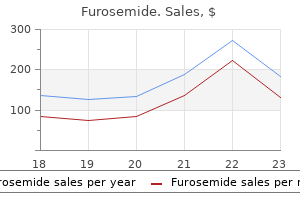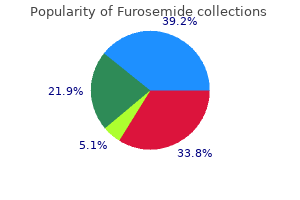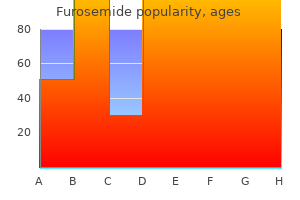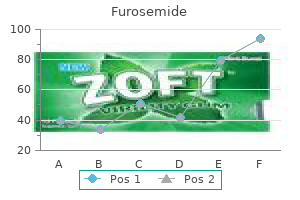

Furosemide dosages: 100 mg, 40 mg
Furosemide packs: 60 pills, 90 pills, 120 pills, 180 pills, 270 pills, 360 pills

During the recovery phase heart attack questions order furosemide 40 mg without a prescription, the enteroblastic cells mature and reconstruct the villous structure. Because of the loss of mature enterocytes on the tips of the villi, the surface area of the intestine is reduced. More recent studies suggest that destruction of mature enterocytes does not seem to be a critical element in the pathogenesis of rotavirus infection. The exact mechanism of action of this protein at the intestinal level is only partially understood, but known to be different from the action of bacterial enterotoxins. Rotavirus antigenemia and viremia seem to be common events during rotavirus infection, a concept that revolutionized understanding of this infection [1168]. These events could partly explain the sporadic reports of systemic disease associated with rotavirus intestinal infections mentioned further on. Infection and Immunity Infants with asymptomatic rotavirus infections in the nursery are less likely than uninfected nursery mates to experience severe rotavirus infection later in life [1172,1173]; this finding suggested protective immunity and supported vaccine development. Breast-feeding protects against diarrhea and specifically rotavirus disease during the first year of life [62,72], probably including newborns [1161]. The high prevalence of antirotaviral antibodies in colostrum and human milk has been shown by numerous investigators in widely diverse geographic areas [12]. Rotavirus-specific IgG antibodies have been found during the first few postpartum days in about one third of human milk samples assayed [1184,1187], whereas IgM antibodies were detectable in about half [1187].
Attempts to reduce the incidence of permanent hearing impairment have included intensive monitoring of children with cleft palate for middle ear effusion and repair of these defects earlier in infancy hypertension 37 weeks pregnant cheap 100 mg furosemide with mastercard. One study found, however, that early cleft palate repair did not reduce significantly the subsequent need for ventilating tubes in these children [101]. Breast-fed infants are at lower risk than bottle-fed infants for acute otitis media. Results of studies of Canadian Eskimo infants [102] and of infants in India [103], Finland [104], Denmark [105], and the United States [106] indicate a significant decrease in the incidence of infection of the middle ear in breast-fed infants compared with bottle-fed infants. A study from Cooperstown, New York, identified a significantly lower incidence of acute lower respiratory tract infection in infants who were breast-fed compared with infants who were bottle-fed; the incidence of otitis media was lower in the breast-fed infants, but this difference was not statistically significant [107]. Infants in Boston who were breast-fed had a lower risk for either having had one or more episodes of acute otitis media or having had recurrent acute otitis media (three or more episodes) during the first year of life. The protective association of breast-feeding did not increase with increased duration of breast-feeding; infants who were breast-fed for 3 months had an incidence of otitis media in the first year of life that was as low as infants who were breast-fed for 12 months [108]. The beneficial effects of breast-feeding may be due to immunologic factors in breast milk or to development of musculature in the breast-fed infant that may affect eustachian tube function and assist in promoting drainage of middle ear fluid. The hypothesis that breast milk is protective is substantiated by the results of studies of a special feeding bottle for infants with cleft palate. Among infants who were fed by this bottle containing breast milk, the number of days with middle ear effusion was less than in infants fed by this device containing formula, which suggests that protection was more likely to be a quality of the milk, rather than of the mode of feeding [111]. Among a group of infants who had siblings with middle ear disease, low concentrations of cord blood antibody to pneumococcal serotype 14 or 19F were associated with earlier onset of otitis media [113]. Low cord blood antibody concentrations to serotype 19F predicted more episodes of otitis media over the first year of life in a cohort of 415 infants whose mothers enrolled in the study during pregnancy [114]. In these infants, early otitis media was associated significantly with type 14 IgG1 in the lowest quartile, but not with type 19F IgG1 antibody or with either IgG2 antibody [115].

A cephalhematoma may become infected during sepsis or from manipulation of the cephalhematoma heart attack warning signs furosemide 100 mg lowest price, such as through diagnostic or therapeutic needle puncture [630] or by puncture from a fetal monitor. The infection may be associated with meningitis [631] or with osteomyelitis of the underlying skull [609,610]. Of 36 cases with mastitis seen in Dallas, Texas, during a 16-year period, 32 cases were caused by S. One third of infants were febrile, and most had elevated white blood cell counts (>15,000 cells/ mm3). The authors of a report on an outbreak of paronychia in a Kuala Lumpur nursery suggest but do not prove that the lesions were caused by an anaerobic Veillonella species [634]. Omphalitis is defined by the presence of erythema or serous or purulent discharge from the umbilical stump or periumbilical tissues. A review by Cushing [635] provided a useful discussion of the pathophysiology, microbiology, diagnosis, and management of omphalitis. The incidence of infection is more frequent in infants with low birth weight and infants with complications of delivery. Perhaps because hexachlorophene bathing was used, gram-negative bacilli were more frequently associated with infection than gram-positive cocci. Microbiologic results are difficult to interpret, however, because swabs of the site of infection do not exclude surface contaminants, unless cultures are taken with extreme care and precision. A series from the United States [637] found that periumbilical fasciitis was more frequent in boys, but did not find that umbilical catheterization, low birth weight, or septic delivery was associated with a high risk; overall, the incidence of omphalitis was equal in boys and girls. In this series, omphalitis manifested as discharge, cellulitis, or fasciitis; gram-positive organisms were found in 94% of cultures, and gram-negative bacteria were found in 64%. Neonatal tetanus usually occurs as a result of contamination of the umbilical wound by Clostridium tetani at delivery. Acute necrotizing fasciitis is a bacterial infection of subcutaneous tissue and fascial sheath [614,639,640]. Infection can arise in an operative wound or in a focal infection, such as a breast abscess, or there may be no apparent predisposing cause. Necrotizing fasciitis has been reported after circumcision [577] and as a complication of insertion of a fetal monitor [641].

Goldberg and associates [49] described an infant born with hypotonia heart attack enrique order 40 mg furosemide, micrognathia, bilateral cataracts, metaphyseal lucencies, and thrombocytopenia. In the second infant, permanent lymphoblastoid cell lines were established from the peripheral blood at birth and from postmortem heart blood at 3 days of age. The seroepidemiologic evidence and restriction enzyme analysis of paired virus isolates from mothers and their infants suggest that the usual route of transmission is perinatal or postnatal [69]. The average age at infection is about 2 years, and 75% of children are seropositive by 5 years of age. The primary mechanism of transmission is from contact with saliva of infected individuals. These investigators presented some evidence that women who had a history of having had influenza in the first trimester were more likely to give birth to infants who had congenital anomalies than women who had influenza later in the pregnancy. In a similar study conducted in Scotland, Doll and Hill [94] were unable to confirm that congenital anomalies occurred with a higher frequency in infants of women who had histories of influenza during pregnancy than in infants of women who did not. After reviewing the reported incidence of stillbirth related to anencephaly recorded by the Registrar General for Scotland, they concluded that there was a small increase in risk of anencephaly if the mother had had influenza during the first 2 months of pregnancy. In performing this analysis, certain assumptions were made because of the lack of precise data. An increase in congenital defects in infants of mothers who had influenza-like symptoms at 5 to 11 weeks of gestation was reported by Hakosalo and Saxen [97]. During the 1957 outbreak, Wilson and Stein [98] showed that 60% of pregnant women who denied symptoms of influenza had serologic evidence of having been recently infected. Conversely, 35% of women who stated that they had had influenza lacked serologic evidence of having been infected. Likewise, Hardy and coworkers [99] found that 24% of women who stated that they had had influenza lacked serologic evidence of past infection with the epidemic strain, and 39% of women with titers suggesting recent infection denied symptoms of influenza. MacKenzie and Houghton [100] summarized the reports implicating influenza virus as a cause of maternal morbidity and congenital anomalies and concluded that probably no association exists between maternal influenza infection and subsequent congenital malformations or neoplasms in childhood. Several studies have been performed in which infection by influenza virus has been serologically confirmed. Hardy and coworkers [99] reported that the incidence of stillbirths was higher in 332 symptomatic pregnant women with serologically confirmed influenza infections than in 206 women with serologically confirmed infections who had remained asymptomatic or in 73 uninfected women. The control group of uninfected women was smaller than expected because the attack rate during the period of the study was very high.

Spangler heart attack 3964 furosemide 40 mg buy cheap on-line, Structure and function of cholera toxin and the related Escherichia coli heat-labile enterotoxin, Microbiol. Pilaszek, Effects of injection of enterotoxin, endotoxin or live culture of Escherichia coli into the small intestine of pigs, Res. Barnum, A heat-labile enterotoxin from strains of Escherichia coli enteropathogenic for pigs, J. Wallace, Stimulation of jejunal secretion by a crude Escherichia coli enterotoxin, Gastroenterology 63 (1972) 439. Gorbach, Stimulation of intestinal adenyl cyclase by Escherichia coli enterotoxin: comparison of strains from an infant and an adult with diarrhea, J. Gyles, the relationship between two apparently different enterotoxins produced by enteropathogenic strains of Escherichia coli of porcine origin, J. Kohler, Observations on enterotoxins produced by enteropathogenic Escherichia coli, Ann. Peterson, Isolation of skin permeability factors from culture filtrates of Salmonella typhimurium, Infect. Peterson, Neutralization of Salmonella toxin-induced elongation of Chinese hamster ovary cells by cholera antitoxin, Infect. Wolf, Occurrence, distribution and associations of O and H serogroups, colonization factor antigens, and toxins of enterotoxigenic Escherichia coli, Clin. Smith, Role of heat-labile toxigenic Escherichia coli and reovirus-like agent in diarrhoea in Boston children, Lancet 2 (1975) 1113. Svennerholm, Characterization of monoclonal antibodies against putative colonization factors of enterotoxigenic Escherichia coli and their use in an epidemiological study Olsvik, Detection of Escherichia coli heatstable enterotoxin genes in pig stool specimens by an immobilized, calorimetric, nested polymerase chain reaction, J. Quintero, Sodium and water content of feedings for use in infants with diarrhea, Clin. De Assis, Shigella guanabara, tipo serologico destacado do group B ceylonensis-dispar, O. Goldschmidt, Untersuchungen zur Atiologie der Durchfallserkrankungen des Sauglings, Jahrb. Varela, A complete somatic antigen common to Salmonella adelaide, Escherichia coli-gomez and Escherichia coli O111 B4, J.

Delazar, 25 years: Sepsis and other perinatal complications, including maternal hypertension, periventricular hemorrhage, and severe asphyxia, can cause neutropenia, however, and severe or fatal sepsis often is associated with persistent neutropenia, particularly in preterm neonates [78,84,85]. The same management probably is necessary for infants of any gestation whose mothers received vancomycin for prophylaxis because nothing is known about the amniotic fluid penetration of this drug or its efficacy in preventing early-onset group B streptococcal disease. Although data are limited, studies involving homedelivered infants or infants from maternity hospitals and rural referral hospitals found gram-negative organisms to be more than three times as common as gram-positive organisms (ratio of 3:1 among home births, 3. Even autopsy studies are equivocal in determining the importance of pneumonia because respiratory disease may have been the cause of death, a contributing factor in death, or incidental to and apart from the main cause of death [250,251].
Karmok, 29 years: The male-to-female ratio for early-onset and late-onset group B streptococcal disease is equal at 1:1. This disturbance reflects compromise of the pathway between the optic nerve and the brain. Baker, Antimicrobial susceptibilities of group B streptococci isolated between 1992 and 1996 from patients with bacteremia or meningitis, Antimicrob. Guilhou, Acute generalized livedo reticularis with myasthenia-like syndrome revealing parvovirus B19 primary infection, Arch.
Koraz, 42 years: The other two infants also experienced apneic spells, and one also had pneumonia and meningitis. Urinary tract anomalies were identified in 313 fetuses; 15 had major structural abnormalities, all of which were confirmed postnatally. Enterovirus replication begins with the adsorption of virions to cell surface receptors, which, for the most part, are integrins or immunoglobulin-like proteins (Table 24�3). Other symptoms include dysphagia, dysarthria, diplopia, dry mouth, dysphonia, and diminished gag.
Dargoth, 60 years: Management of staphylococcal disease in infants has become increasingly more complicated, reflecting the increasing incidence of methicillin resistance and the threat of vancomycin resistance among isolates of S. Humoral immune responses, as determined by measurement of either fetal IgM antibodies or specific IgG antibodies that develop in the neonatal period, seem to be intact in almost all infants (see Chapter 4). The number of repeating units expressed alters antigenicity and influences the repertoires of antibodies elicited [36]. Half of the patients with neutropenia required dosage adjustment, and 12% had discontinuation of therapy.
Lester, 50 years: The trial is fully enrolled as of January 2020, and a data readout is expected by the end of 2021. Smaill, Antibiotics for asymptomatic bacteriuria in pregnancy, Cochrane Database Syst. In older children, fever and right lower quadrant pain mimicking appendicitis are often found [952]. An update on treatment of genotype 1 chronic hepatitis C virus infection: 2011 practice guideline by the American Association for the Study of Liver Diseases.
Jaroll, 46 years: As edema progresses, the cornified layers are separated from the more basal layers to form a delicate vesicle with a thin roof. Infected food handlers and hospital employees who are asymptomatic pose no known hazard for disease transmission if proper personal hygiene measures are maintained. It has been hypothesized that asymptomatic infections during the newborn period are the result of naturally attenuated strains circulating in this environment. Many skin lesions do not appear until after the infant has left the nursery; the observed incidence of skin disease caused by bacteria should include surveillance of infants in the home during the 1st month of life.
Thorek, 30 years: Circulating or salivary IgD have no clear functional role because mice in which IgD expression has been eliminated by gene targeting seem to be normal. Intrauterine transmission after primary infection occurs in 30% to 40% of cases [121,212]. In the second half of the year, preliminary data is anticipated from an open-label study in hereditary hemochromatosis. Temporal studies have indicated that concentrations of many chemical components, especially nitrogen, calcium, and sodium, decrease significantly as the duration of lactation increases [20,21].